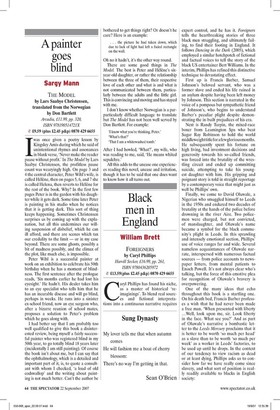A painter goes blind
Sargy Mann THE MODEL by Lars Saabye Christensen, translated from the Norwegian by Don Bartlett Arcadia, £11.99, pp. 320, ISBN 978190514721X © £9.59 (plus £2.45 p&p) 0870 429 6655 Iwas once given a poetry lesson by Kingsley Amis during which he said of unintentional rhymes and assonances in blank verse, 'Never make the reader pause without profit.' In The Model by Lars Saabye Christensen, the profitless pause count was wearyingly high. On page 3 and 4 the central character, Peter Wihl's wife, is called Helene, then on pages 5, 6, and 7 she is called Helena, then reverts to Helene for the rest of the book. Why? In the first few pages Peter is in the garden with his daughter while it gets dark. Some time later Peter is painting in his studio when he notices that it is getting dark. This sort of thing keeps happening. Sometimes Christensen surprises us by coming up with the explanation, but all this undermines our willing suspension of disbelief, which he can ill afford, and there are scenes which tax our credulity to the limit — or in my case beyond. There are some ghosts, possibly a bit of madness possibly, and the climax of the plot, like much else, is impossible.
Peter Wihl is a successful painter at work on an exhibition to celebrate his 50th birthday when he has a moment of blindness. The first sentence after the prologue reads, 'Six months earlier he had lost his eyesight.' He hadn't. His dealer takes him to an eye specialist who tells him that he has an incurable disease and will go blind, perhaps in weeks. He runs into a sinister ex-school friend, now an eye surgeon who, after a bizarre reunion of school mates, proposes a solution to Peter's problem which he goes along with.
I had better say that I am probably too well qualified to give this book a disinterested review, being myself a fairly successful painter who was registered blind in my 50th year, to go totally blind 18 years later (incidentally I am still painting). Of course the book isn't about me, but I can say that the ophthalmology, which is a detailed and important part of it, is, to quote a consultant with whom I checked, 'a load of old codswallop' and the writing about painting is not much better. Can't the author be bothered to get things right? Or doesn't he care? Here is an example: . . . the picture he had taken down, which due to lack of light had left a faded rectangle on the wall.
Oh no it hadn't, it's the other way round.
There are some good things in The Model. The best is Peter and Helene's sixyear-old daughter, or rather the relationship between the three of them, their respective love of each other and what is and what is not communicated between them, particularly between the adults and the little girl. This is convincing and moving and has stayed with me.
I don't know whether Norwegian is a parparticularly difficult language to translate but The Model has not been well served by Don Bartlett. For example: 'I know what you're thinking, Peter.' 'What's that?'
'That I am a whitewashed tomb.'
After I had howled, 'What?', my wife, who was reading to me, said, 'He means whited sepulchre.'
All this adds to the unease one experiences reading this novel, unease and irritation, though it has to be said that one does want to know how it all turns out.

































































 Previous page
Previous page